Category:1001 General Requirements for Material: Difference between revisions
m link update |
|||
| Line 598: | Line 598: | ||
A sample record shall be completed in accordance with [http://contribute.modot.mo.gov/business/materials/pdf/vol_3/MMV3CONT.pdf Automation Section]. | A sample record shall be completed in accordance with [http://contribute.modot.mo.gov/business/materials/pdf/vol_3/MMV3CONT.pdf Automation Section]. | ||
The sampler should assign an identification number to each sample (refer to the QRG [[ | The sampler should assign an identification number to each sample (refer to the QRG [[:Category:101 Standard Forms#Sample Record General Information |Sample Record General Information]]). This number is to be shown on the sample tag, one tag attached to the bag and one tag placed inside the bag, accompanying the sample. Show the identification number on the second shipping tag or separate piece of paper and place inside each sample bag. This procedure provides a simplified reference to the sample should the shipping tag become lost and it becomes necessary for the Central Laboratory to contact the sampler. | ||
Classification of Sample. Sample type is selected on the Basic Sample Data tab in SM (refer to the QRG Sample Record General Information). | Classification of Sample. Sample type is selected on the Basic Sample Data tab in SM (refer to the QRG Sample Record General Information). | ||
Revision as of 11:22, 5 February 2019
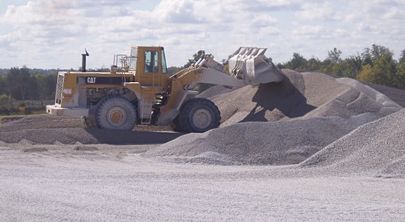
This article establishes procedures for material acceptance that includes necessary sample types and frequencies, required test methods, sampling procedures and reporting. This article also establishes requirements for acceptance of dust suppressant additives.
Sample weights (masses) are to be considered as minimum weights (masses).
1001.1 Duties
The duty of an aggregate inspector is to ensure that only materials with initial evaluation and source approval are incorporated into the final product The inspector will verify that materials are produced from the ledges or source as stated on the mix design. Aggregate inspectors must be familiar with all ledge configurations in the district and be able to differentiate ledges in the quarry. Quarry visits should be made as necessary to visually verify that production is from the ledges as stated on the mix design. The aggregate inspector shall ensure that required sampling frequencies and testing procedures comply with the specifications.
1001.1.1 Initial Evaluation
1001.1.2 Diary
The inspector will maintain a bound diary describing the daily activities in accordance with EPG 106.20.11 Internal Material Records.
1001.2 Producer Quality Management
When producer quality management is specified, the material producer is responsible for the following system prescribed with this specification. The goal of producer quality management is to have the producer take necessary actions to control and document the quality of their products to ensure they are specification compliant.
Each producer must provide Quality Control (QC) during production as a first line of inspection and testing. Producers must also provide an Independent Quality Assurance (QA) of the testing and inspection performed by QC. This independent QA may not be performed by QC or any other entity internal of the producer. Independent QA may either be qualified testing personnel or an industry recognized auditing organization. MoDOT will audit producers at its discretion, including QC reviews, QA reviews, product testing, record reviews, etc.
1001.2.1 Producer Quality Management Plan (QMP)
Each producer will submit a QMP to MoDOT detailing the basis of their QC/QA program. MoDOT will generally review the QMP and accept it based on compliance with specifications. Care should be taken when accepting the producer’s QMP to anticipate problems and work them out before production begins. Central Office Construction and Materials will review the QMP for consistency with standard practices and compliance with the specification.
Testing and Inspection
The QMP should list all of the testing and inspection practices routinely performed to ensure compliance with the specification and production of a quality product. Some MoDOT specifications list specific testing frequencies and the QMP should not undermine those frequencies without proper justification. Producer QA should follow the testing requirements as stated in the specifications and should only vary with justification. For producers that select third party QA testing the producer shall indentify a third party testing lab that is AMRL certified to perform tests.
Record Keeping
Each producer should have a system for recording, compiling and storing testing and inspection related information. The exact method is not important, but must be thorough enough to allow specific test and inspection results to be retrieved when needed for individual products or lots. Since MoDOT’s auditing will be largely based off of these records, attention should be given to ensure record keeping will serve that purpose and be easy to use. MoDOT can request the producers records at any time with the intent of records being used for auditing, research, or specification compliance.
Deficient Work, Non-Conforming Work and Disputes
The QMP should outline the procedure for product that does not comply with the specification and how to handle any disputes that arise. Similar to contractor performance management, QC should catch deficient work, document, and correct it when possible. The QMP should contain details covering all common deficient work and corrective actions. Work that cannot be corrected by QC or is found after QC approves the product is considered non-conforming work and should trigger a Non-Conformance Report (NCR). The QMP should detail how NCRs are distributed and resolved. A third party dispute resolution testing firm should be listed in the QMP for use when the MoDOT’s audit results do no verify the QC/QA process.
1001.2.2 Producer QA
Each producer covered by this specification must comply with one of two methods of providing an independent QA verification of their QC program. The minimum frequency of QA testing is found in the specification.
- a) Independent QA Testing Firm. The producer at their expense will employ an independent firm to periodically perform QA verification of QC test results. The independent testing firm should be an AMRL accredited laboratory. To be considered independent, the testing firm should have no direct business ownership tie to the producers.
- b) Industry Recognized Audit Program. Since producers may participate in an organization or process that is recognized by MoDOT to represent industry quality standards. If the organization provides an auditing/testing function it may count as independent QA under these specifications.
1001.2.3 Control of Deficient Work
Deficient work is defined as work not compliant with the specification found by QC. Deficient work may be corrected by QC as outlined in the QMP with MoDOT’s approval. QC will document all deficient work and corrective actions taken. An individual product’s common deficient work may be listed in an EPG article along with typical MoDOT approved repair methods that the producer may use.
When deficient work cannot be corrected as outlined in the QMP it becomes non-conforming work.
1001.2.4 Control of Non-Conforming Work
Non-conforming work is defined as work not compliant with the specification found by QC that cannot be corrected as routine practice outlined in the QMP or work not compliant with the specification found after QC accepts the products.
It is the producer’s responsibility to initiate an Non-Conformance Report (NCR) and suggest a corrective action. “Use As Is” may be an acceptable corrective action, but impacts to MoDOT should be considered in accessing a possible reduction in cost. Each QMP should designate a MoDOT contact for all NCR’s and that contact will coordinate the official MoDOT response ensuring that all necessary divisions and offices are involved.
Usually both the Engineer and contractor should be involved and give approval for an NCR’s resolution to ensure no conflicts arise with design, costs, or constructability.
When a producer shows a pattern of NCRs reoccurring for an issue, MoDOT should address the issue with the producer as outline in the specification. This should be initiated by written letter outlining our concern and the history of the issue. If the producer’s attempts to address the issue are unacceptable, the issue should be escalated to Construction and Materials Division. Failure to address the issue may result in rejection of the producers QMP which would make all products by the producer non-compliant and unacceptable.
1001.2.5 Hold Points
Hold points are defined by the QMP as any item that requires verification before work can continue. The QMP will list QC hold points and may have MoDOT hold points also. Usually each hold point will have a physical sign off and inspection sheet that is kept as part of the producers quality records.
A list of MoDOT hold points required is found in the specification and may be altered by the engineer when the QMP is approved to cover special circumstances. MoDOT may waive individual hold points at the discretion of the engineer. MoDOT should notify the producer as soon as possible when we intend to waive/miss a hold point to ensure we do not delay the producer.
The producer is responsible for notifying MoDOT sufficiently in advance of a MoDOT hold point to ensure inspectors are available and will not delay the producers operation.
1001.2.6 MoDOT Quality Assurance and Audits
The frequency of MoDOT Quality Assurance Testing and Audits will be determined by the specification and EPG guidance for individual products. MoDOT Quality Assurance Testing of products should occur on a quarterly basis as long as the producer is manufacturing products for MoDOT use, otherwise MoDOT Quality Assurance Testing is not necessary. The most common audit will be a once a year audit of documentation in SiteManager, including any test results. A good auditing practice is to choose an incorporated product from the producer and verify the records for that individual product. An audit may occur at any time when producer QC and Independent QA of MoDOT Quality Assurance testing does no compare or other continual non-compliance discrepancies occur.
When a producer’s PQM involves a third party testing service, the accreditation should be checked as well as the test results.
When a producer’s PQM involves industry QA, MoDOT should either witness the industry QA audit or review the results as part of our audit process.
Issues discovered during an audit may result in NCRs for individual products or be addressed through modification of the PQM or other corrective action.
1001.3 Sampling Procedures
Sampling procedures shall be in accordance with AASHTO T2. Portions shall be combined and reduced in accordance with AASHTO T248.
When sampling a stockpile, it is recommended that separate samples be taken from different parts of the pile, care being taken to avoid any segregated areas and bearing in mind that the material near the base of the pile is likely to be segregated and coarser than the average of the material in the stockpile.
Table 1001.3 Size of Original Field Samples
| Maximum Size of Particle1 | Minimum Weight (Mass) of Sample, lb. (kg)2 |
|---|---|
| 2” (50 mm) | 80 (36) |
| 1-1/2" (37.5 mm) | 54 (25) |
| 1" (25.0 mm) | 36 (16) |
| 3/4" (19.0 mm) | 22 (10) |
| 1/2" (12.5 mm) | 14 (6) |
| 3/8" (9.5 mm) | 10 (5) |
| 1 Maximum size of particle is defined as the smallest sieve through which 100 percent of the material will pass. | |
| 2 The samples prepared for testing shall be obtained from the field sample in accordance with AASHTO T248 | |
1001.4 Types of Samples
1001.4.1 Initial Evaluation
Sampling for initial evaluation shall be done by, or under the supervision of the District Geologist.
1001.4.1.1 Mines and Quarries
Producers should be reminded that all quarries will be sampled initially on a "ledge" basis regardless of intended use. The initial sample will be obtained for Central Laboratory testing from each ledge of stone that varies from the adjacent material. Sampling shall be in compliance with all federal, state and local safety requirements. It is suggested that the sample be obtained from the pile after each ledge has been excavated.
1001.4.1.2 New Formations or Special Investigations for Portland Cement Concrete Pavement Aggregates

The district is to consult with Construction and Materials prior to sampling.
A new formation is defined as one the department has not previously tested and approved for PCCP. It shall also apply to a new source of a previously tested formation if an examination of the new source indicates that the material may have different properties.
Special investigations are instances such as testing a previously rejected ledge in combination with approved ledges or other situations the department chooses to investigate. Initial evaluation for new formations or special investigations for use in PCCP shall start with a review of the service performance of concrete pavement utilizing aggregate from that formation and source (or nearby source). The paving could be city, county, commercial, etc. As much documentation as possible on age, mix design, etc. should be collected and a field review of the installations performed. If service performance is poor, the review may stop at this point and no testing performed. If service performance is satisfactory, sampling and testing may proceed. Approval of formations for use in production of aggregate for PCCP will require completion of AASHTO T161 Resistance of Concrete to Rapid Freezing and Thawing.
1001.4.1.3 Gravel and Sand Sources
A representative sample shall be obtained from the deposit. However, initial evaluation samples from the deposit will not be required provided plant produced material can be obtained meeting specification requirements, in which case the material may be submitted to the Central Laboratory for Source Approval (see Source Approval).
Samples should not be obtained from each of several plants located on the following sources: the Kansas, Missouri, Mississippi and Arkansas Rivers. Two samples per year, per stream, per district will be satisfactory for these sources.
1001.4.1.4 Lightweight (Low Mass Density) Aggregates
Manufactured lightweight (low mass density) aggregates prepared by expanding, calcining or sintering argillaceous materials such as clay, shales and slates shall be sampled. Care shall be exercised to obtain a representative sample. However, Initial Evaluation samples will not be required provided plant produced material meeting specification requirements can be obtained, in which case the material shall be submitted to the Central Laboratory for Source Approval Samples.
1001.4.1.5 Other Mineral Aggregates
Other mineral aggregates such as previously produced material, chat, slag, or other manufacturing by-products shall be treated as special cases. The district shall obtain instructions from Construction and Materials, prior to sampling these materials.
1001.4.1.6 Sampling
The mine or quarry site should be examined thoroughly, with care taken to obtain samples that represent each of the various ledges exposed in the mine or quarry face being sampled. A ledge stone sample shall include only those materials that indicate the inherent quality of the stone. Any materials, which are identifiable as being deleterious, shall not be included in the sample of the stone, since the Specifications will control the amount of such material that can be tolerated in the finished product. The Assistant State Construction and Materials Engineer must approve any deviation from the above procedure.
1001.4.1.7 Size of Sample
New formation or special investigation samples for use in PCCP or PCCM, when required, shall consist of approximately 2000 pounds (1000 kg) of material for each single ledge of stone. All other samples for the Initial Evaluation sample, representing a single ledge of stone, shall consist of 150 pounds (70 kg) of material.
1001.4.1.8 Producer Identification
It is important for historical tracking reasons to keep good records of changes in operators and locations. A facility number (producer/supplier code) is associated with a particular location and shall remain the same through changes in ownership. The exact name and location along with the facility number is to be used when referencing a particular source. If the name changes, subsequent reports, samples and correspondence should use the new name with a footnote * (* previously named) until sufficient permanent file records establish a record. A new facility number will only be issued for a new location.
1001.4.1.9 Identification of Sample
A SM record, for Initial Evaluation samples, is to be filled out in accordance with Automation Section. Ledge numbering instructions are in Automation Section 3900. The record shall indicate that the sample type is Gen Appr Initial. Instructions for entering ledge descriptions into SM are also located in Automation Section 3900.
1001.4.1.10 Columnar Sections
A columnar section, produced from SM, shall accompany all ledge stone samples. Instructions for developing columnar sections and the correct templates to use in SM are in Automation Section 3900.
1001.4.1.11 Time Required for Central Laboratory Tests
Individual times required to complete the tests may be longer than listed below, depending on the number of samples undergoing tests in the Central Laboratory.
Coarse aggregate from a previously approved source or formation intended for use in Portland cement concrete requires a minimum of 16 working days after receipt of the sample in the Central Laboratory.
Coarse aggregate from new formations intended for use in Portland cement concrete requires a minimum of 5 months after receipt of the sample in the Central Laboratory. As an option the producer may hire an independent laboratory to perform the tests. MoDOT must approve the independent laboratory and the test results submitted to MoDOT for interpretation and verification.
Coarse aggregates intended for other uses require a minimum of four working days.
1001.4.1.12 Initial Evaluation of Material
| Durability Factor, Paving Concrete |
| Report 2009 |
| See also: Innovation Library |
Free Form and Initial Evaluation templates on SM test reports for Initial Evaluation samples will indicate the uses for which the material may be suitable, subject to the results obtained on the Source Approval Samples. The following codes, listed in order of hierarchy, will be used for Initial Evaluation:
- 1005CACP, Initial Evaluation Suitable for all uses
- 1005CACM, Initial Evaluation Suitable for all uses except PCCP
- 1002CAAC, Initial Evaluation Suitable for all uses except PCCP, PCCM and 1003 Grade A
- 1004CABS, Initial Evaluation Suitable for only Bit Surface and Agg Base
- 1006CAAS, Initial Evaluation Suitable for only Agg Surface and Agg Base
- 1007CAAB, Initial Evaluation Suitable for only Agg Base
Material produced for Sec 502 Portland Cement Concrete Base and Pavement per Sec 1005 may be produced from any combination of ledges so long as each ledge has had an Initial Evaluation and the specific combination of ledges has had a prior Source Approval of PCCP quality or the combined ledges has had AASHTO T161 testing performed and has met the minimum durability requirements of Sec 1005. Material, excluding Section 1005 for PCCP may be produced from any combination of ledges that have an initial evaluation. Source Approval for the final product must be for a specific ledge combination and must meet the specification for which it is produced.
1001.4.1.13 Producer Notification
The producer is to be notified in writing of the aggregate uses for which each ledge is suitable. The letter is to explain that tests for Initial Evaluation are performed on each ledge in order to determine the inherent quality of the stone. The notification is to state that samples of crushed aggregates produced to comply with Sec 1005, Sec 1004 or Sec 1002 will have to be submitted to the Central Laboratory for Source Approval. The producer is also to be reminded that any produced aggregate must meet all other requirements of the specifications for the intended use. A copy of the letter shall be forwarded to Construction and Materials, Physical Laboratory.
All correspondence to aggregate producers concerning Initial Evaluation is to be addressed using information from the materials producers file as shown in SM as follows:
- Contact Person
- Facility Full Name or short Name (either)
- P. O. Box or Street Address (Address part 2)
- City, State, Zip Code
The producer supplier name and producer supplier number is to be shown at the bottom of the page as a filing reference in the manner indicated in the external correspondence standards, e.g.:
- City Wide #1, Sugar Cr. Quarry
- 3003000114
1001.4.2 Source Approval Samples
Source Approval based on Central Laboratory test results will be required on aggregates produced for use to meet the quality requirements of Sec 1002, Sec 1003 Grade A, Sec 1004 and Sec 1005. Source Approval is not required for Sec 1006, Sec 1007 or Sec 1009 unless the ledges have not previously been sampled. No produced material of this type is to be accepted for use until a Source Approval sample has been tested and approved by the Central Laboratory unless the material is from an operating quarry, which previously had Source Approval. Note that Sec 1009 specifications require a minimum of Sec 1002 quality.
1001.4.2.1 Sampling
Samples are to represent the final product that has been produced to meet a definite specification and intended specific use. Source Approval samples will be required each year and should be obtained at the site of production. Source Approvals intended for PCCP, that have not previously been approved or tested for PCCP, will require completion of AASHTO T161 Resistance of Concrete to Rapid Freezing and Thawing. AASHTO T161 testing will not be required on a yearly basis, however, if physical properties of aggregate for a specific combination of ledges vary significantly from previous Source Approval samples, T161 testing may be requested by the Central Laboratory. Source samples, submitted to the Central Laboratory for testing, shall not be used for combination purposes such as trial mix or any purpose other than Source Approval. Source Approvals are required for each unique combination of ledges represented by the mix design. Only one Source Approval is required when fractions of varying gradations are produced from the same ledges. These samples will be obtained from production of the aggregate with district personnel verifying the ledge(s) for the product. If ledge configuration changes during production, a new mix design will be required, and a new Source Approval taken to represent the material produced. Sampling for Source Approval may be more frequent than yearly if changes in the material are observed.
When multiple ledges are incorporated into the product, consideration to method of sampling should be given so the sample represents all ledges being combined. A representative sample shall be secured by obtaining three or more approximately equal increments, selected at random from a stockpile. When sampling during production, the increments shall be gathered over a period time sufficient to ensure the sample represents all ledges being combined. The increments shall be combined to form a field sample whose mass equals or exceeds the minimum recommended.
1001.4.2.2 Size of Sample
Source Approval samples of coarse aggregate submitted to the Central Laboratory shall consist of 150 pounds (70 kg) of any fraction of material produced with the maximum size no smaller than 1/2 in. (12.5 mm) nor larger than 1-1/2 in. (37.5 mm). Source Approval of fine aggregate from natural deposits (i.e.; natural sand) shall consist of 50 pounds. Source Approval samples intended for PCCP that require T161 testing shall consist of 650 pounds (300 kg).
1001.4.2.3 Identification of Sample
A SM sample record, for Source Approval samples, is to be filled out in accordance with Automation Section. The record shall indicate that the sample type is "Gen Appr Source (All General Items)." Before selecting a material code for aggregate submitted for coarse aggregate for concrete, the inspector should refer to the QLIS Source report located in the Materials – Aggregate folder of Cognos 8. This report lists Source Approval samples submitted to the Lab by quarry and is grouped by ledge or ledge combination. If a ledge or ledge combination has never had prior PCCP approval or AASHTO T161 testing performed, the material cannot be considered for PCCP until a sample has had AASTHO T161 testing performed. Material codes containing PCCP apply only to material representing specific ledges or ledge combinations that meet at least one of the following:
- prior PCCP approval
- completed AASHTO T161 testing compliant with Specification 1005 minimum durability factor and or other tests required to evaluate the material
- a sample that is being submitted for T161 testing to either the Lab or an approved outside lab.
Material that does not meet the requirements for PCCP should be submitted with a PCCM Only material code. The Plant ID field is to be filled out with the appropriate ledge or ledge combination prior to submitting the sample to the Lab. The Sample ID number(s) under which the ledge(s) or deposit was tested, and given Initial Evaluation, shall be shown under the Other Tab with the type set to “Initial Evaluation Sample ID #”. Use successive rows with multiple Initial Evaluations and enter ID # in corresponding column.
1001.4.2.4 Time Required for Central Laboratory Tests
The actual tests conducted in the Central Laboratory on Source Approval samples will depend on the uses for which the produced aggregate is intended.
Previously approved formation and member sources for coarse aggregate for Portland cement concrete requires a minimum of 16 working days from the date received in the Central Laboratory.
Source Approval samples of fine aggregate for Portland cement concrete require a minimum period of ten working days for complete tests.
Coarse and fine aggregate for uses other than Portland cement concrete will require a minimum of four working days for the completion of tests.
1001.4.2.5 Approval of Material
Remarks on test reports for Source Approval samples will state that the sample does or does not comply with specifications for the particular use intended. When compliance is indicated, this constitutes approval of the produced aggregate represented by the sample for the uses shown.
When ledges are being re-sampled in accordance with Re-sampling of Approved Ledges, production may continue to be accepted providing preliminary test results indicate specification compliance for the material. However, Source Approval samples should be submitted as soon as possible for the evaluation of future production.
If a producer elects to produce material before Source Approval is granted, the district shall notify the producer by letter that the producer is producing without approval and at risk of rejection. A copy of the letter shall be forwarded to the State Construction and Materials Engineer.
1001.4.2.6 Producer Notification
The producer is also to be notified in writing of the results of tests on Source Approval samples of material produced to meet the requirements of Sec 1002, Sec 1003 Grade A, Sec 1004 and Sec 1005. The letter is to list the ledges represented by each source sample and reiterate that crushed aggregate must meet all other requirements of the specifications for which it is specifically being produced. A copy of the letter shall be forwarded to the State Construction and Materials Engineer.
All correspondence to aggregate producers concerning Source Approval is to be addressed using information from the materials producers file as shown in SM as follows:
- Contact Person
- Facility Full Name or Short Name (either)
- P. O. Box or Street Address (Address part 2)
- City, State, Zip Code
The producer supplier name and producer supplier number is to be shown at the bottom of the page as a filing reference in the manner indicated in the external correspondence standards, e.g.:
- City Wide #1, Sugar Cr. Quarry
- 3003000114
1001.4.3 Re-sampling of Approved Ledges
An approved ledge may be re-sampled any time aggregate produced from the ledge has a significant change in color, texture, characteristics, or performance in the approved use. Either the producer or MoDOT can request a new Initial Sample. If requested by the producer, the district must concur. This sample is intended to serve as a quality check sample on material in the ledge. When sampling is performed, the same procedure as outlined for Initial Evaluation sampling is to be followed. Produced material previously approved prior to re-sampling and that produced during Central Laboratory testing, shall be accepted. The sample record shall indicate reasons for re-sampling in the remarks. The preceding Initial Evaluation Laboratory number shall be listed under the Other Tab, with the Type set to “Initial Evaluation Sample ID #”.
1001.4.4 Absorption as Received and Rodded Unit Weight (Mass) Samples
1001.4.4.1 Sampling
Samples of aggregate for Portland cement concrete from various sources for rodded unit weight (mass) and absorption as received tests may be submitted by the district. Sampling may be at the site of production or destination. Results of these tests will be informational only and used at the discretion of the district. When verifying mix designs, absorption and unit weight test results from Source Approval samples may be used for reference.
1001.4.4.2 Size of Sample
(a) 50 pounds (25 kg) of material, or 50 pounds (25 kg) of each fraction in the case of split paving stone, is sufficient for a rodded unit weight (mass) test.
(b) A one gallon (4 liter) friction top metal can completely filled with aggregate (one gallon (4 liter) can of each fraction in the case of split paving stone) is sufficient for the absorption as received test. The lid of the container is to be secured immediately after filling, so that moisture cannot escape from the aggregate. The sample should be submitted to the Central Laboratory as soon as possible after being obtained.
(c) Samples for both tests should be obtained from current production, if possible, and should comply with all requirements of the Specifications. In order to obtain representative samples of the material produced, the samples should be obtained at intervals throughout the production period. A SiteManager sample record shall be completed in accordance with Automation Section and submitted with the sample. Representative field gradations and quality determinations are to be shown and submitted with each sample marked "Production Sample" and indicating "Unit Weight (Mass)" or "Absorption".
1001.4.5 Trial Mix Samples for Bituminous Mixtures
Samples of raw materials for use in bituminous mixtures may be required by the Central Laboratory in order to verify the mix design.
1001.4.5.1 Sampling
The district's Construction and Materials Engineer shall request the contractor to furnish the name and location of the supplier or producer for each of the various materials proposed for use in the trial mixtures. This can be done at or through the Pre-Construction Conference. Where sources of materials are from a District other than the project location, the contractor should be advised to contact the District's Construction and Materials Engineer in that District for necessary inspection. It is the responsibility of the inspecting District to determine if the proposed aggregate sources have initial evaluation and Source Approval, before submitting the trial mix samples.
With the contractor's concurrence, the District Construction and Materials Engineer or designated representative shall be responsible for obtaining the necessary samples of mineral aggregates to be submitted to the Central Laboratory for use in trial mixtures. However, the gradations being submitted should first be approved by either the contractor or representative and it is their responsibility to submit the proposed trial mix formula to the District Engineer. The district's Construction and Materials Engineer should make every effort to expedite this so the Central Laboratory will have sufficient time for testing.
Extreme care should be used, when obtaining trial mix samples to ensure the gradations are representative of the material being produced for that particular bituminous mixture. Recommended practice to obtain trial mix samples is by accumulating representative portions of routine job control samples over a period of several days’ production until a sufficient quantity has been saved. This quantity should then be mixed thoroughly and reduced to the desired sample size to obtain the gradation for use in the trial mix formula. If there is insufficient time to use the above method then the gradation of the trial mix samples, however obtained, should be compared for compatibility with prior job control gradations. Good judgment should be exercised as to whether the trial mix sample gradation is representative of production and should be submitted for trial mix.
Material produced for trial mix samples shall be obtained from specific ledge combinations. This ledge combination represented by the sample must be maintained throughout production of the stockpile being produced.
1001.4.5.2 Size of Sample
Minimum sizes of samples for these materials shall be as follows:
Table 1001.4.5.2 Minimum Size of Trial Mix Samples
| Type of Mixture Desired | 1Minimum Total Pounds (kg) of Material |
|---|---|
| Recycled Asphaltic Concrete | 150 (75) RAP |
| 200 (100) coarse aggregate | |
| 150 (75) sand | |
| Other Asphaltic Concrete | 250 (125) coarse aggregate |
| 150 (75) each, natural and/or manufactured sand | |
| Two (2) Asphaltic Concrete Mixes Submitted in Combination2 | 400 (200) coarse aggregate |
| 200 (100) each, natural and/or manufactured sand | |
| Plant Mix Bituminous Pavement or Surface Leveling Plant Mix | 200 (100) coarse aggregate |
| 100 (50) sand or screenings | |
| Plant Mix Bituminous Base | 250 (125) coarse aggregate |
| 100 (50) sand or screenings (if used) | |
| 1 If the coarse aggregate is furnished in more than one fraction, a minimum of 150 pounds (75 kg) of each fraction should be submitted. | |
| 2 If mixes are being submitted in combination and only two fractions are used, 200 pounds (100 kg) of each should be submitted. | |
To avoid delays, good judgment should be exercised. It is better to send too much material than too little. Each sample shall be properly identified to correspond with the SM sample record, which shall be filled out to show all of the necessary information concerning the sample.
1001.4.5.3 Procedure to Ensure Aggregate Gradation Uniformity
After obtaining the required quantity of aggregate, the following procedures are recommended to ensure the gradation of the aggregate in each bag is as nearly the same as possible.
- (a) If 2 bags, 100 pounds (50 kg), are required:
Split 50 pounds (25 kg) (one bag) into 1/2 portions and place into two bags. Repeat with second bag adding to material in bags containing material split from first bag.
- (b) If 4 bags, 200 pounds (100 kg) are required:
Combine 100 pounds (50 kg) (2 bags) using the 100 pounds (50 kg) (2 bags) method. Repeat with remaining 100 pounds (50 kg) (2 bags). Take 50 pounds (25 kg) (one bag) from each group and combine using 100 pounds (50 kg) (2 bags) method. Repeat with remaining bags.
- (c) If 8 bags, 400 pounds (200 kg) are required:
Combine 200 pounds (100 kg) (4 bags) using the 200 pounds (100 kg) (4 bags) method. Repeat with remaining 200 pounds (100 kg) (4 bags). Take 50 pounds (25 kg) (one bag) from each group and combine using 100-pound (50 kg) (2 bags) method. Repeat with remaining bags.
- (d) If 16 bags, 800 pounds (400 kg) are required:
Combine 400 pounds (200 kg) (8 bags) using the 400 pounds (200 kg) (8 bags) method. Repeat with remaining 400 pounds (200 kg) (8 bags). Take 50 pounds (25 kg) (one bag) from each group and combine using 100-pound (50 kg) (2 bags) method. Repeat with remaining bags.
A "Gilson Splitter" with a bag attachment is recommended for these procedures.
If an odd number of bags are required, prepare the trial mix sample with the next larger number of bags in the above methods and throw away surplus bags. For example, if 250 pounds (125 kg) (5 bags) is required, prepare 400 pounds (200 kg) (8 bags), select 50 pounds (25 kg) (one bag) for the field gradation, throw 100 pounds (50 kg) (2 bags) away and submit 250 pounds (125 kg) (5 bags) to the Central Laboratory.
1001.4.5.4 Identification of Sample
A SM sample record for trial mix samples is to be filled out in accordance with Automation Section. The record shall indicate that the sample type is “Trial Mix”. The Sample ID number(s) under which the ledge(s) or deposit was tested and given source approval, shall be shown under the Other Tab. Select Source Approval and enter ID # in corresponding column.
1001.4.6 Compaction Standard Samples
1001.4.6.1 Sampling
Compaction Samples are those samples submitted to the Central Laboratory to determine compaction characteristics of aggregate used for base in construction projects.
Compaction samples should be submitted in advance of incorporation for comparison per Sec 304. These samples may be taken at the site of production. The sample shall represent specific material incorporated into the project. Samples for compaction characteristics may be submitted any time a question of the composition of material used for compaction is questioned. Change in gradation is an indicator for difficulty in achieving density. The inspector should verify QC records to ensure that gradation of the Base material as produced reflects the gradation as submitted for compaction.
1001.4.6.2 Size of Sample
A sample shall represent a unique combination of ledges. Sample shall consist of 100 pounds (50 kg) of material (2 bags).
1001.4.6.3 Identification of Sample
A SM record for Compaction Standard samples is to be filled out in accordance with Automation Section. The record shall indicate that the sample type is “Compaction Standard”. The ledge source should also be noted under “Plant ID” on the Addtl Sample Data Tab.
1001.4.7 Absorption Samples for Bituminous Surfacing
1001.4.7.1 Sampling
Absorption samples for bituminous surfacing may be submitted to the Central Laboratory to determine absorption of material produced for use as graded aggregate for bituminous surfacing.
Absorption samples for bituminous surfacing represent aggregate produced to meet the quality requirements of graded aggregate for bituminous surface. These samples may be submitted to the Central Laboratory as needed to determine absorption. The samples shall be submitted from production and represent the product incorporated into the project.
1001.4.7.2 Size of Sample
A sample shall represent a unique combination of ledges or deposit location. Sample shall consist of 50 pounds (25 kg) of material (1 bag).
1001.4.7.3 Identification of Sample
A SM record for Absorption samples is to be filled out in accordance with Automation Section. The record shall indicate that the sample type is “General Prod Absorption”. The ledge source should also be noted under “Plant ID” on the Addtl Sample Data Tab.
1001.4.8 Aggregate for Maintenance
Aggregate purchased for maintenance may be sampled at destination or site of production for acceptance. The sample location will depend on where MoDOT takes possession of the material. Material hauled by MoDOT personnel will be sampled at the production site. Material hauled by the supplier will be sampled at the destination and should be sampled prior to incorporating with previously accepted material. Material shall comply with the specifications as purchased. A minimum of one gradation and one deleterious shall represent approximately every 1500 tons delivered. Central Laboratory samples are not required. Acceptance is based on field test results and does not require Source Approval unless material is specified under Sec 1002, Sec 1003 Grade A, Sec 1004 and Sec 1005. For verification of acceptance a split sample may be submitted to the Central Laboratory. Contact Construction and Materials for instructions on submitting these samples.
1001.5 Field Testing Procedures
1001.5.1 Sieve Analysis
The frequency of aggregate Quality Assurance tests shall be in accordance with the specifications. This includes retained samples from quality control tests and independent samples. Sieve analysis of mineral filler shall be in accordance with AASHTO T37. Sieve analysis for the determination of particle size distribution of coarse and fine aggregate shall be performed in accordance with AASHTO T27 and T11, with the following exceptions.
1001.5.1.1 Apparatus
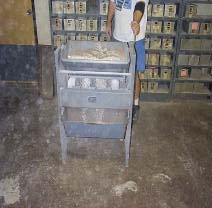
- (a) Stove - Electric, natural gas, propane, or other suitable burner capable of maintaining a controlled temperature, may be used in lieu of an oven.
- (b) Pans - Pans of sufficient size and quantity for washing and drying samples and for holding separated fractions of material.
- (c) Brass sieve brush.
- (d) Large spoon or trowel.
- (e) Sample splitter.
1001.5.1.2 Sample Preparation
Samples of aggregate for sieve analysis shall be taken in accordance with EPG 1001.3 Sampling Procedures and reduced to the proper size for testing in accordance with AASHTO T248. The sample for testing shall be approximately the size shown below and shall be the end result of the sampling method. The selection of samples of an exact predetermined weight (mass) shall not be attempted.
Table 1001.5.1.2 Size of Testing
| Coarse Aggregate | |
|---|---|
| Maximum Size of Particle1 | Minimum Weight (Mass) of Sample lb. (kg) |
| 2" (50 mm) | 20 (9) |
| 1-1/2" (37.5 mm) | 13.5 (6) |
| 1" (25.0 mm) | 9 (4) |
| 3/4" (19.0 mm) | 5.5 (2.5) |
| 1/2" (12.5 mm) | 3.5 (1.5) |
| 3/8" (9.5 mm) | 2.5 (1) |
| 1 Maximum size of particle is defined as the smallest sieve through which 100 percent of material will pass. | |
| Fine Aggregate | |
| Manufactured Fines and Natural Sand | 500 grams |
1001.5.1.3 Procedure
The sieve analysis shall be performed in accordance AASHTO T27. When determination of the minus 200 material is required, this shall be performed in accordance with AASHTO T11. A dry gradation may be run on any material where the accuracy of the sieve analysis does not require washing. The district Construction and Materials Engineer should be consulted when there is a question as to whether a dry or washed gradation should be run.
1001.5.1.4 Worksheet Form T-630R and Calculations, Passing Basis
One method for calculating gradation on a passing basis is as follows: The material that has been separated by the sieving operation shall be weighed starting with the largest size retained. This weight (mass) shall be recorded in the plant inspector's workbook on the line corresponding to the sieve on which the material is retained. Examples are given in Fig 1001.10.2 Form T-630R Example 1, page 1 and page 2. The second largest sized material is then added to the largest size in the weigh pan and the accumulated total is recorded on the line corresponding to the sieve on which the material is retained. This operation is continued with the accumulated total being recorded on the line corresponding to the sieve on which the material is retained down to the smallest sieve, in this example, the No. 200 (75 m) size sieve. The final quantity of material remaining in the pan (in this instance, minus No. 200 (75 m) material) should be recorded on the line designated as "PAN." The "PAN + LOSS" is the sum of the "LOSS" from washing over a No. 200 (75 m) sieve plus the amount retained in the "PAN". The quantity retained on the smallest sieve is then added to the quantity in the "PAN + LOSS" and is to be recorded on the line designated as "TOTAL". The "TOTAL" should equal the original dry weight (mass) within a tolerance of one gram for each sieve that the material passed through. The difference between the "TOTAL" and the "ORIGINAL DRY WEIGHT (MASS) is recorded on the line designated "DIFFERENCE". Tolerance for the sieving is plus or minus 1 gram per sieve. In the examples above, the tolerance should be equal to or less than plus or minus 5 grams (five sieves were used, beginning with the smallest sieve through which 100 percent passed). This tolerance is to be recorded on the line designated as "SIEVE ACCURACY".
The total amount of material finer than the smallest sieve shall be determined by adding the weight (mass) of material passing the smallest sieve obtained by dry sieving to that lost by washing. In the example, the amount lost by washing as recorded on the "LOSS" line was found to be 442 grams. The 7 on the "PAN" line shows that 7 additional grams were obtained in the dry sieving operation. This total quantity, 449 grams, is recorded on the "PAN + LOSS" line.
Except for the smallest sieve used, the percent passing is determined by dividing the quantity shown for each sieve by the original dry weight (mass) and subtracting the percentage from 100. The percentage passing the smallest sieve is found by dividing the quantity shown on the "PAN + LOSS" line by the original dry weight (mass). The percentage for the smallest sieve is shown on the line for that sieve.
Enter the SM Sample ID in the column next to “RECORD NO,” then enter information from Form T-630R in SM.
Fig 1001.10.3 Form T-630R, Example 2 shows Form T-630R being used to record the gradation of a material produced to meet Section 1003 specifications.
1001.5.2 Plasticity Index
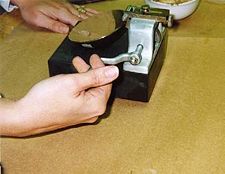 |
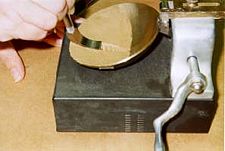 |
The frequency of plastic index Quality Assurance tests shall be in accordance with the specifications. This includes retained samples from quality control tests and independent samples for quality assurance. The plasticity index is defined as the numerical difference between the liquid limit and the plastic limit. The liquid limit is the moisture content, expressed as a percentage of the weight (mass) of the oven-dried material, that the soil will flow together ½ in. (13mm) at 22-28 blows. The plastic limit is the minimum moisture content, expressed as a percentage of the weight (mass) of the oven dried material, that the soil thread can no longer be rolled into 1/8 in. (3mm) diameter thread. All original weights (masses) and calculations shall be recorded on Form T-630R (See Fig 1001.10.1 Form T-630R, page 1 and page 2.
1001.5.2.1 Apparatus
- (a) Apparatus for liquid limit shall conform to Section 3 of AASHTO T89. Liquid limit device may be either mechanically or manually operated. A curved grooving tool shall be used per Method B. All measurements, calibrations and adjustments shall be made in accordance with AASHTO T89 Method B. An example of material at the liquid limit is shown in Fig 1001.10.4 Liquid Limit and Plastic Limit Tests.
- (b) Apparatus for plastic limit shall conform to Section 3 of AASHTO T90. A Plastic Limit Rolling Device shall not be used. Material shall be rolled using the Hand Rolling Method. An example of the crumbling of the thread is shown in Fig 1001.10.4 Liquid Limit and Plastic Limit Tests.
1001.5.2.2 Procedures
The liquid limit shall be determined in accordance with AASHTO T89 Method B, with the exception of material preparation. Material preparation shall be in accordance with MoDOT Test Method TM 79.
1001.5.2.3 Calculations
Plasticity index is calculated per AASHTO T90, as the difference between the liquid limit and plastic limit. Reported to the nearest whole number.
1001.5.2.4 Report
All original weights (masses) and calculations shall be recorded on Form T-630R. If the material is such that the plastic limit cannot be determined, the material is to be considered non-plastic. A SM sample record for independent samples is to be filled out in accordance with Automation Section. The record shall indicate that the sample type is “Quality Assurance”, Acceptance Method is “Accepted/Complete”, the QA data for tests should be entered on test templates as follows: Plasticity Index on SAA008AB1.
- 1The last letter of this template is subject to change if the template is revised. The most current template should have the designation ‘NEWEST’ before its description.
1001.5.3 Percent Deleterious Substances in Coarse Aggregate
The inspector shall determine the percent of deleterious substances in coarse aggregate, when required, in accordance with MoDOT Test Method TM 71. Determination of deleterious is required for Source Approval samples.
Deleterious shall be determined on the combined aggregate for Hot Mix Asphalt sampled from the cold feed belt at the asphalt plant. The test data shall be recorded on the Plant Inspector’s Excel Worksheet.
Deleterious shall be determined on individual fractions for material produced for Portland Cement Concrete Masonry. A SM record shall be created that represents the specific product code and producer/supplier source of the coarse aggregate. The sample type shall be “Quality Assurance”. One test per 500 cu. yd. of concrete, regardless of class of concrete, is required per fraction of aggregate. One test may represent multiple projects. The test data should be reported in conjunction with gradation, absorption and thin/elongated. Contracts should be attached on the SM record.
Deleterious shall be determined on individual fractions for material produced for Portland Cement Concrete Pavement. A SM record shall be created that represents the specific product code and producer/supplier source of the coarse aggregate. The sample type shall be “Quality Assurance”. Testing frequency shall comply with specifications.
1001.5.4 Lightweight (Low Mass Density) Particle Content including Coal and Lignite in Fine Aggregate
The inspector shall determine the lightweight particle content in accordance with MoDOT Test Method TM 71. The test shall be performed according to AASHTO T113 except that lightweight (low mass density) sand particles are not considered deleterious lightweight (low mass density) particles.
1001.5.5 Percent Other Deleterious Substances, Clay Lumps and Shale in Fine Aggregate
The inspector shall determine the percent other deleterious substances, clay lumps and shale in accordance with MoDOT Test Method TM 71.
1001.5.6 Thin or Elongated Pieces
The inspector shall determine the percent thin or elongated pieces when required. The test shall be in accordance with ASTM D4791.
1001.5.7 Absorption
Sampling and testing for absorption of concrete aggregates shall be in accordance with AASHTO T85, excluding Section 8.2 or shall be in accordance with TM-81, Specific Gravity and Absorption of Aggregate Using Automatic Vacuum Sealing Method. It is important the test sample be initially dried to a constant mass, as absorption values will be higher if the sample is not dried.
1001.5.7.1 Sampling
Sample shall be taken at destination, but coordination of testing should be done prior to the date of the pour. Material tested shall represent material incorporated into the project. One test per 500 cu. yd. of concrete, regardless of class of concrete, is required per source of aggregate. One test may represent multiple projects. Contracts should be attached on the SiteManager record.
1001.5.7.2 Report
A SiteManager record shall be created that represents the specific product code and producer/supplier source of the coarse aggregate. The sample type shall be Material Approval. Test data will be reported on template SAA005BA1, Independent AASHTO T85 Absorption for Concrete Agg for tests performed for PCCM and PCCP Independent Samples. Test data shall be reported on template SAA005AA1, Retained AASHTO T85 Absorption for Concrete Agg for tests performed on PCCP Retained Samples. Samples tested using the MoDOT TM 81 should use template SAA005CA, CoreLok Absorption and Specific Gravity. The test data should be reported in conjunction with gradation, deleterious and thin/elongated
- 1 The last letter of this template is subject to change if the template is revised. The most current template should have the designation ‘NEWEST’ before its description.
1001.6 Records and Reports
1001.6.1 Plant Inspection Aggregate Worksheet Form T-630R
Form T-630R is bound in workbook form entitled "Plant Inspection of Aggregates". Form T-630R is provided to record original test results performed at an aggregate plant. All original data and test results will be entered directly into the workbook. Recording on a scratch sheet for later entry is not permitted. No erasures are permitted. If errors are made, they shall be lined out but not obliterated and corrections noted.
Form T-630R is basically a self-explanatory form; however, a few items to note are as follows. If the book is to be used only for one material at one plant, the basic plant information need only be shown on the first page. If more than one material or plant is recorded in the same book, the plant information may be required on other pages. The inspector should sign or initial the sheet filled out for that day or in the provided spaces if more than one day's tests are listed on a sheet.
Any test results indicating out of specification material shall be circled and a notation made as to the corrective action taken or disposition of rejected materials. Test results representing samples submitted to the Central Laboratory shall be identified. Other items shall be recorded as required by local conditions.
When a book has been completed, it shall be maintained as required at the district's discretion; however, the books shall be retained for a minimum of five years.
1001.6.2 Reporting Accuracy
Aggregates graded on a passing basis are to be reported to the same number of places shown in the specifications. Note that minus No. 200 (75 m) material in portland cement concrete aggregates is specified to 0.1 percent.
1001.7 Rounding-Off Procedures
The actual rounding-off procedures shall be as follows:
- (a) Test values should be calculated to only one place beyond the last place to be retained and then rounded to the number of places to be reported.
- (b) When the figure next beyond the last place to be retained is less than five, retain unchanged the figure in the last place retained.
- (c) When the figure next beyond the last place to be retained is greater than five, increase by one the figure in the last place retained.
- (d) When the figure next beyond the last place to be retained is five, increase by one the figure in the last place retained if it is odd, leave the figure unchanged if it is even.
- (e) This rounding-off procedure may be restated simply as follows: when rounding off a number to one having a specified number of significant places, choose that which is nearest. If two choices are possible, as when the digit dropped is exactly five, choose the one ending in an even digit.
An example of applying these rules to a "Passing" gradation is as follows:
Table 1001.7.1
| Inch-Pound Units | ||||
|---|---|---|---|---|
| Sec 1005 | Percent | Calculated Gradation | Reported Gradation | Conformance |
| Pass 1 in. | 100 | 99.5 | 100 | Yes |
| Pass 3/4 in. | 90-100 | 94.5 | 94 | Yes |
| Pass 3/8 in. | 15-45 | 34.6 | 35 | Yes |
| Pass No. 4 | 0-5 | 5.5 | 6 | No |
| Pass No. 200 | 0-2.0 | 1.57 | 1.6 | Yes (deleterious) |
| Metric Units | ||||
| Sec 1005 | Percent | Calculated Gradation | Reported Gradation | Conformance |
| Pass 25.0 mm | 100 | 99.5 | 100 | Yes |
| Pass 19.0 mm | 90-100 | 94.5 | 94 | Yes |
| Pass 9. 5 mm | 15-45 | 34.6 | 35 | Yes |
| Pass 4.75 mm | 0-5 | 5.5 | 6 | No |
| Pass 75 m | 0-2.0 | 1.57 | 1.6 | Yes (deleterious) |
Individual deleterious substances for all aggregates are to be reported to the same number of places shown in the specifications. The following is an example of how to compare the sum of the individual deleterious substances with the specified total of all deleterious substances.
Table 1001.7.2
| Sample | Individual Reported Value | Specified Value | Conformance |
|---|---|---|---|
| Deleterious Rock | 5.3 | 6.0 | Yes |
| Shale | 0.8 | 1.0 | Yes |
| Chert in Limestone | 0.0 | 4.0 | Yes |
| Other Foreign Material | 0.1 | 0.5 | Yes |
| Sum of Percentages | 6.2 | 6.0 | No |
Plasticity index and liquid limit are to be reported to the nearest whole number. To achieve this, the liquid limit and plastic limit are each calculated to one decimal place and then rounded off to a whole number. The plasticity index would be the difference between these two whole numbers.
1001.8 Sample Identification
It is extremely important that a sample be properly identified and that complete and accurate information relative to it and the material represented be furnished to the Central Laboratory. A sample record must be completed in SM, on which all pertinent data regarding the sample is shown. This is essential in order to have the proper tests made in the Central Laboratory and the results properly reported to the field.
A sample record shall be completed in accordance with Automation Section.
The sampler should assign an identification number to each sample (refer to the QRG Sample Record General Information). This number is to be shown on the sample tag, one tag attached to the bag and one tag placed inside the bag, accompanying the sample. Show the identification number on the second shipping tag or separate piece of paper and place inside each sample bag. This procedure provides a simplified reference to the sample should the shipping tag become lost and it becomes necessary for the Central Laboratory to contact the sampler.
Classification of Sample. Sample type is selected on the Basic Sample Data tab in SM (refer to the QRG Sample Record General Information).
In addition, the following data should be shown in Remarks on the SM record when applicable to the material being sampled:
- (a) If the material represented has been sampled and tested previously, show this on the record and also give the previous Central Laboratory numbers.
- (b) Always show anything that appears unusual, from field observation, regarding the material being sampled. This is very important, especially if conditions are such that the sample, even though representative, may not reflect the prevailing condition. Such information is often helpful in arriving at a final decision regarding the material.
1001.9 Dust Suppressant Additives
Acceptance of dust suppressant additives will be based on an acceptable manufacturer and brand name approval in accordance with Sec 1001.13 of the Standard Specifications. Each brand and manufacturer for Dust Suppressant Additives are added to the list of “Qualified Dust Supressant Additives”.
1001.10 Figures
Fig 1001.10.1, page 1
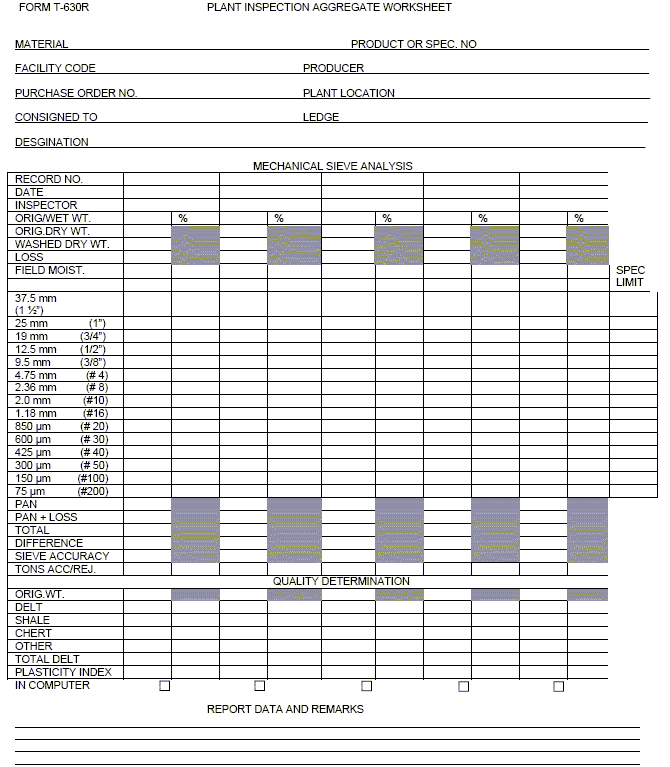
Fig 1001.10.1, page 2
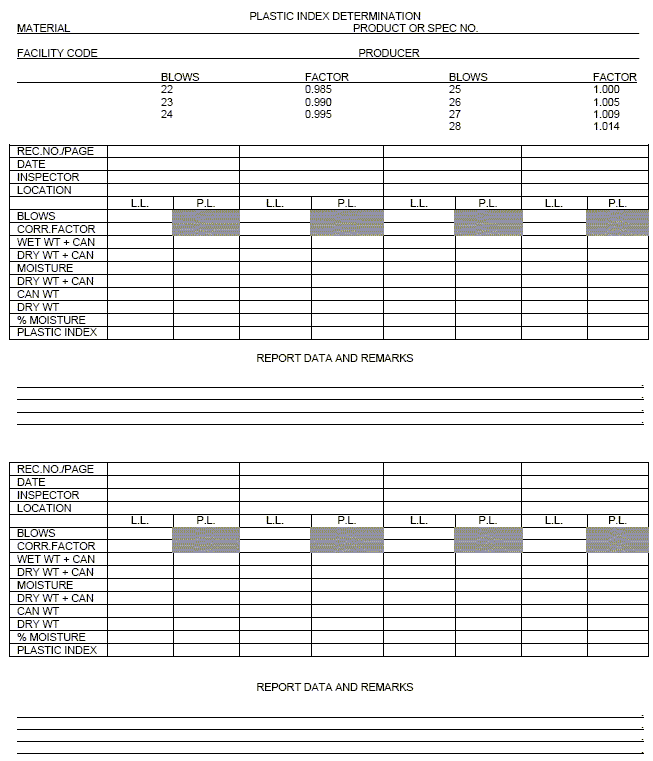
Fig 1001.10.2, page 1
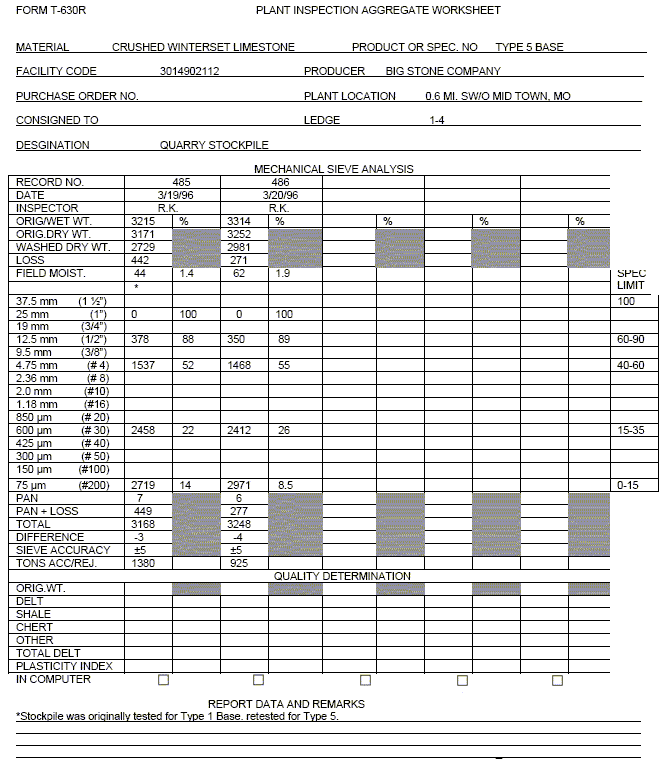
Fig 1001.10.2, page 2
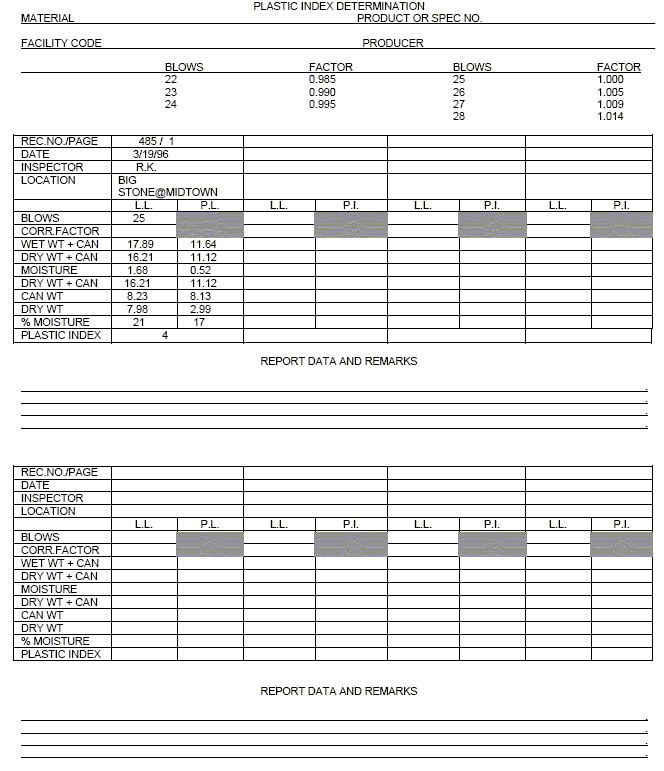
Fig 1001.10.3
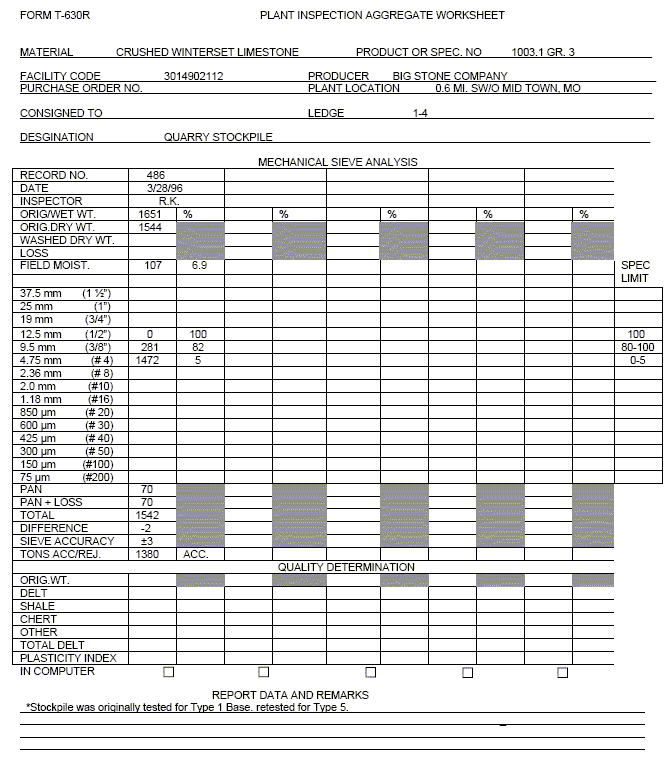
Fig 1001.10.4
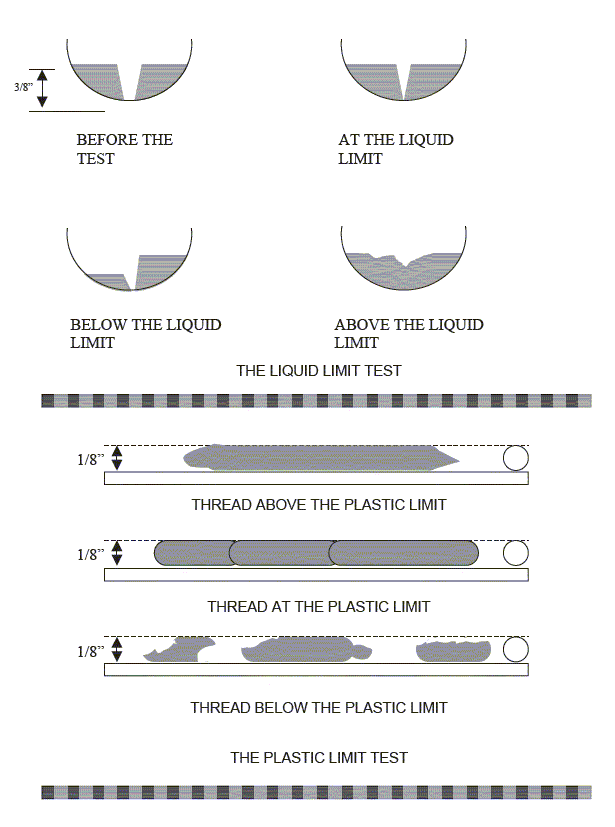
Fig 1001.10.5
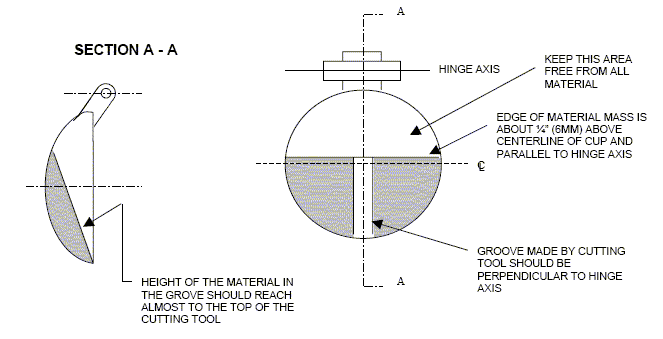
Fig 1001.10.6, page 1
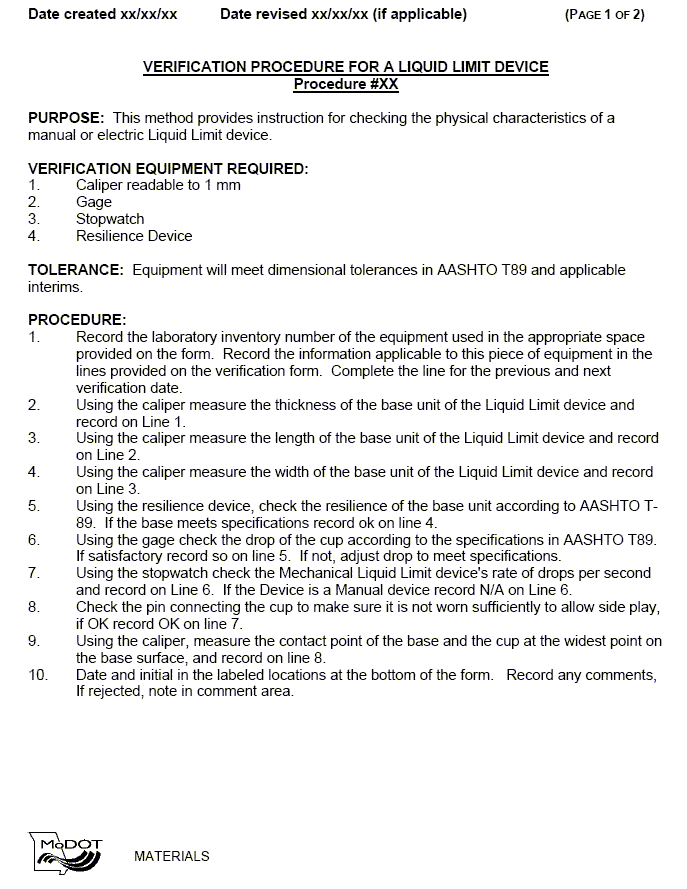
Fig 1001.10.6, page 2
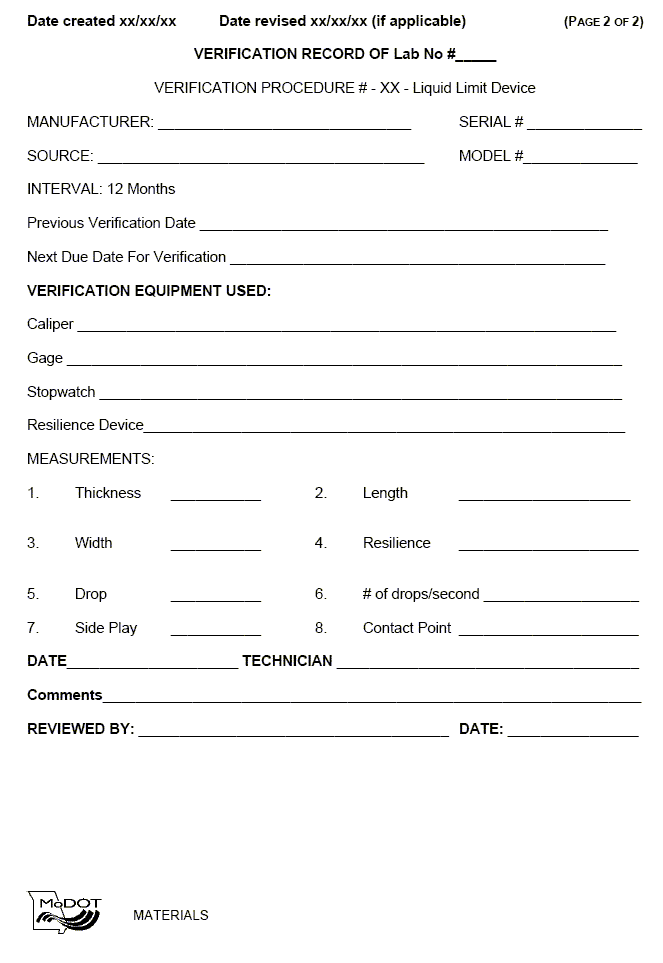
1001.11 Laboratory Testing for Sec 1001
Summary of Required Tests, Procedures, and Sample Records
Tables 1001.11.1 and 1001.11.2 are a summary of information contained in Laboratory Testing Procedures for Sec 1002 through 1009. The sample record shall be completed in SiteManager including sample status as described in Automation Section. Appropriate remarks, as described in EPG 106.20 Reporting, are to be included in the remarks to clarify conditions of acceptance or rejection. Test results shall be reported on the appropriate templates under the Tests tab.
- (a) Tables 1001.11.1 and 1001.11.2 indicate the test required and approximate time required for testing the different types of aggregates and samples.
Table 1001.11.1
| Type Aggregate | Spec Number | Type Sample | Los Angeles Abrasion | Specific Gravity | Absorption | Sieve Analysis | Deleterious | Lightweight Particles | Sodium Sulfate | Alcohol Freeze | Micro Deval | Unit Weight | Mortar Strength | Colorimetric | Plastic Index | Compaction Standard | Minimum Time Required (Days) |
|---|---|---|---|---|---|---|---|---|---|---|---|---|---|---|---|---|---|
| Coarse | 1002.1 | Initial | x | x | x | - | - | - | - | - | - | - | - | - | - | - | 4 |
| Coarse | 1003.1 | Initial | x | x | x | - | - | - | - | - | - | - | - | - | - | - | 4 |
| Coarse | 1004.1 | Initial | x | x | x | - | - | - | - | - | - | - | - | - | - | - | 4 |
| Coarse | 1005.1 | Initial | x | x | x | - | - | - | - | x | x | - | - | - | - | - | 16 |
| Coarse | 1006.1 | Initial | x | x | x | - | - | - | - | - | - | - | - | - | - | - | 4 |
| Coarse | 1007.1 | Initial | x | x | x | - | - | - | - | - | - | - | - | - | - | - | 4 |
| Coarse | 1002.2 | Source | x | x | x | x | x | - | - | - | x | - | - | - | - | - | 4 |
| Fine | 1002.3 | Source | - | x | - | x | x | x | - | - | - | - | - | - | - | - | 4 |
| Coarse | 1004.1 | Source | x | x | x | x | x | - | - | - | x | - | - | - | - | - | 4 |
| Coarse | 1005.2 | Source | x | x | x | x | x | - | x | x | x | x | - | - | - | - | 16 1 |
| Fine | 1005.3 | Source | - | x | x | x | x | x | - | - | - | x | x | - | - | - | 16 |
| 1 If source approval for PCCP, minimum time required would be 150 days. | |||||||||||||||||
Table 1001.11.2
| Type Aggregate | Spec Number | Type Sample | Los Angeles Abrasion | Specific Gravity | Absorption | Sieve Analysis | Deleterious | Lightweight Particles | Sodium Sulfate | Alcohol Freeze | Micro Deval | Unit Weight | Mortar Strength | Colorimetric | Plastic Index | Compaction Standard | Minimum Time Required (Days) |
|---|---|---|---|---|---|---|---|---|---|---|---|---|---|---|---|---|---|
| Coarse | 1005.1 | QC/QA | - | x | x | x | x | - | - | - | - | - | - | - | - | - | 4 |
| Fine | 1005.2 | QC/QA | - | - | - | x | - | - | - | - | - | - | - | - | - | - | 2 |
| Coarse | 1002.1 | Trial Mix | - | x | x | x | x | - | - | - | - | - | - | - | x3 | - | 4 |
| Fine | 1002.2 | Trial Mix | - | x | x | x | - | x1 | - | - | - | - | - | - | x3 | - | 4 |
| Mineral Filler | 1002.3 | Trial Mix | - | x | - | x | - | - | - | - | - | - | - | - | - | - | 3 |
| Coarse | 1005.1 | Absorption as Received | - | x | x | - | - | - | - | - | - | - | - | - | - | - | 3 |
| Fine | 1005.2 | Absorption as Received | - | x | x | - | - | - | - | - | - | - | - | - | - | - | 3 |
| Coarse | 1005.1 | Unit Weight | - | - | - | - | - | - | - | - | - | x | - | - | - | - | 2 |
| Coarse | 1007.1 | Compaction on Standard | - | - | - | x | x2 | - | - | - | - | - | - | - | x | x | 4 |
| 1 Test is performed when a result is reported by the field or when deemed necessary. | |||||||||||||||||
| 2 If requested. | |||||||||||||||||
| 3 Plastic Index performed if sample is limestone or dolomite material, and minus No. 30 is greater than 10%. Plastic Index is performed on all Manufactured Sand and Limestone Screenings. | |||||||||||||||||
